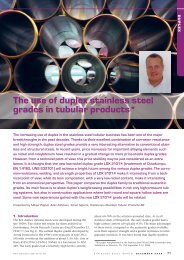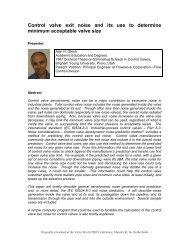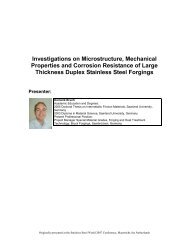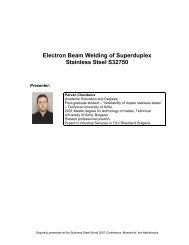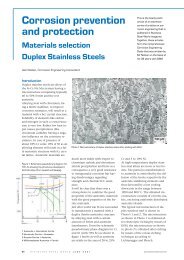Duplex stainless steel welding: best practices*
Duplex stainless steel welding: best practices*
Duplex stainless steel welding: best practices*
You also want an ePaper? Increase the reach of your titles
YUMPU automatically turns print PDFs into web optimized ePapers that Google loves.
Element<br />
Chromium<br />
(Cr)<br />
Nickel<br />
(Ni)<br />
Molybdenum<br />
(Mo)<br />
Nitrogen<br />
(N)<br />
Weight<br />
Percentage (wt %) Elemental Role Alloying Characteristics<br />
18 to 30% Ferrite former • Increasing Cr will increase corrosion resistance.<br />
• The ferrite content increases with increasing Cr; however, too<br />
much Cr will decrease optimal phase balance.<br />
4 to 8% Austenite former • Ni promotes a change in crystal structure from ferrite to<br />
austenite.<br />
• Ni delays the formation of intermetallic phases.<br />
Less than 5% Ferrite former • Enhances pitting corrosion resistance.<br />
• Increased tendency to form detrimental intermetallic phases if<br />
Mo content is too high.<br />
Minimum of 0.14% Austenite former • N causes austenite to form from ferrite at elevated temperatures,<br />
allowing for restoration of an acceptable balance of austenite to<br />
ferrite after a rapid thermal cycle in the HAZ after <strong>welding</strong>.<br />
• Additions of N increase pitting and crevice corrosion resistance<br />
and strength.<br />
• Delays the formation of intermetallic phases.<br />
• Offsets the formation of sigma phase in high Cr, high Mo <strong>steel</strong>s.<br />
Table 2 Importance of alloying elements of DSS.<br />
properties throughout a DSS weldment<br />
are achieved when the phase<br />
balance of ferrite to austenite is<br />
50:50. However, achieving a 50:50<br />
phase balance of ferrite to austenite<br />
(α→γ) in a weldment has proven to<br />
be difficult due to many variables<br />
such as metal chemistry, <strong>welding</strong><br />
processes, and thermal history of the<br />
<strong>steel</strong>. Experience coupled with testing<br />
has shown that DSS have optimal<br />
corrosion resistance and mechanical<br />
properties when 35 to 60%<br />
ferrite content is maintained<br />
throughout the weldment. Figure 1<br />
illustrates the factors that contribute<br />
in achieving the optimal weld properties.<br />
Many fabricators lack sufficient experience<br />
controlling heat input that<br />
achieves a balanced microstructure<br />
in DSS weldments. <strong>Duplex</strong> guidelines<br />
(Figure 1) supplement API 938-<br />
C 1 and suggest parameters for <strong>welding</strong><br />
procedure specifications (WPS)<br />
that will assist welders achieve the<br />
optimum (α→γ) balance.<br />
Metallurgy<br />
Alloying Elements<br />
For DSS producers there is no difficulty<br />
in meeting standard specifications<br />
of chemical compositions.<br />
Individual <strong>steel</strong> producers have narrow<br />
target compositions within<br />
ASTM/ASME specifications to meet<br />
different criteria. DSS are sensitive<br />
to variations in composition, particularly<br />
of those elements controlling<br />
the phase balance. The relatively<br />
broad chemical limits permit large<br />
variation in properties.<br />
There are three basic categories of<br />
DSS, low-alloy, intermediate alloy,<br />
and highly alloyed, or superduplex<br />
<strong>stainless</strong> <strong>steel</strong> (SDSS) grades,<br />
grouped according to their pitting<br />
resistance equivalent number<br />
(PREN) with nitrogen and are<br />
shown in Table 1. The most widely<br />
used alloys are DSS-grade 2205+ and<br />
SDSS-grade 2507.<br />
The remarkable corrosion resistance<br />
and mechanical properties of DSS are<br />
attributed to the rich alloy content of<br />
chromium, nickel, molybdenum,<br />
and nitrogen that form austenite in a<br />
ferritic matrix. The combination of<br />
high chromium and high molybdenum<br />
is a cost-efficient way to achieve<br />
good chloride pitting and crevice<br />
corrosion resistance because of the<br />
reduced amount of nickel compared<br />
to austenitic SS. The superior attributes<br />
of DSS are credited to the interactions<br />
of alloying elements forming<br />
complex microstructures. The importance<br />
of alloying elements is explained<br />
in Table 2.<br />
Optimum (α → γ) Balance<br />
Ferrite content of DSS will indicate<br />
whether proper <strong>welding</strong> and/or heat<br />
treatment techniques result in corrosion<br />
resistance and mechanical<br />
properties that fulfil engineering requirements.<br />
The presence of ferrite<br />
in DSS imparts the superior chloride<br />
stress corrosion cracking (CSCC) resistance<br />
and high strength. An increase<br />
of ferrite content causes behaviour<br />
similar to a ferritic SS. When<br />
the amount of austenite in DSS increases,<br />
strength will decrease while<br />
corrosion resistance and susceptibility<br />
to CSCC increases. As a consequence,<br />
ferrite limits should be specified<br />
within a reasonable range and<br />
be used as a control measure.<br />
When low temperature impact<br />
properties are required, ferrite content<br />
must be carefully controlled.<br />
Figure 2 Corrosion rate and impact energy vs.<br />
percent ferrite of DSS.<br />
Figure 3: DSS micrograph (200X) 4<br />
As the ferrite content exceeds approximately<br />
60%, there will be a noticeable<br />
decrease in the ductile behaviour<br />
and pitting resistance.<br />
Sources indicate there may be a negative<br />
effect on ductile behaviour<br />
with ferrite levels below 35%, and<br />
reduced resistance to SCC due to a<br />
change in the solidification mode<br />
causing segregation and precipitation<br />
of intermetallic phases 3 .<br />
Although it is common to see 30-<br />
65% ferrite specified for base and<br />
weld metal and 30-70% ferrite HAZ,<br />
our experience shows a range between<br />
35-60% ferrite provides optimal<br />
results.<br />
Figure 2 is a theoretical diagram that<br />
illustrates how ferrite content affects<br />
DSS materials. The dotted curve<br />
represents the corrosion rate in<br />
chloride containing aqueous envi-<br />
54 S T A I N L E S S S T E E L W O R L D D E C E M B E R 2 0 0 7 www.<strong>stainless</strong>-<strong>steel</strong>-world.net



